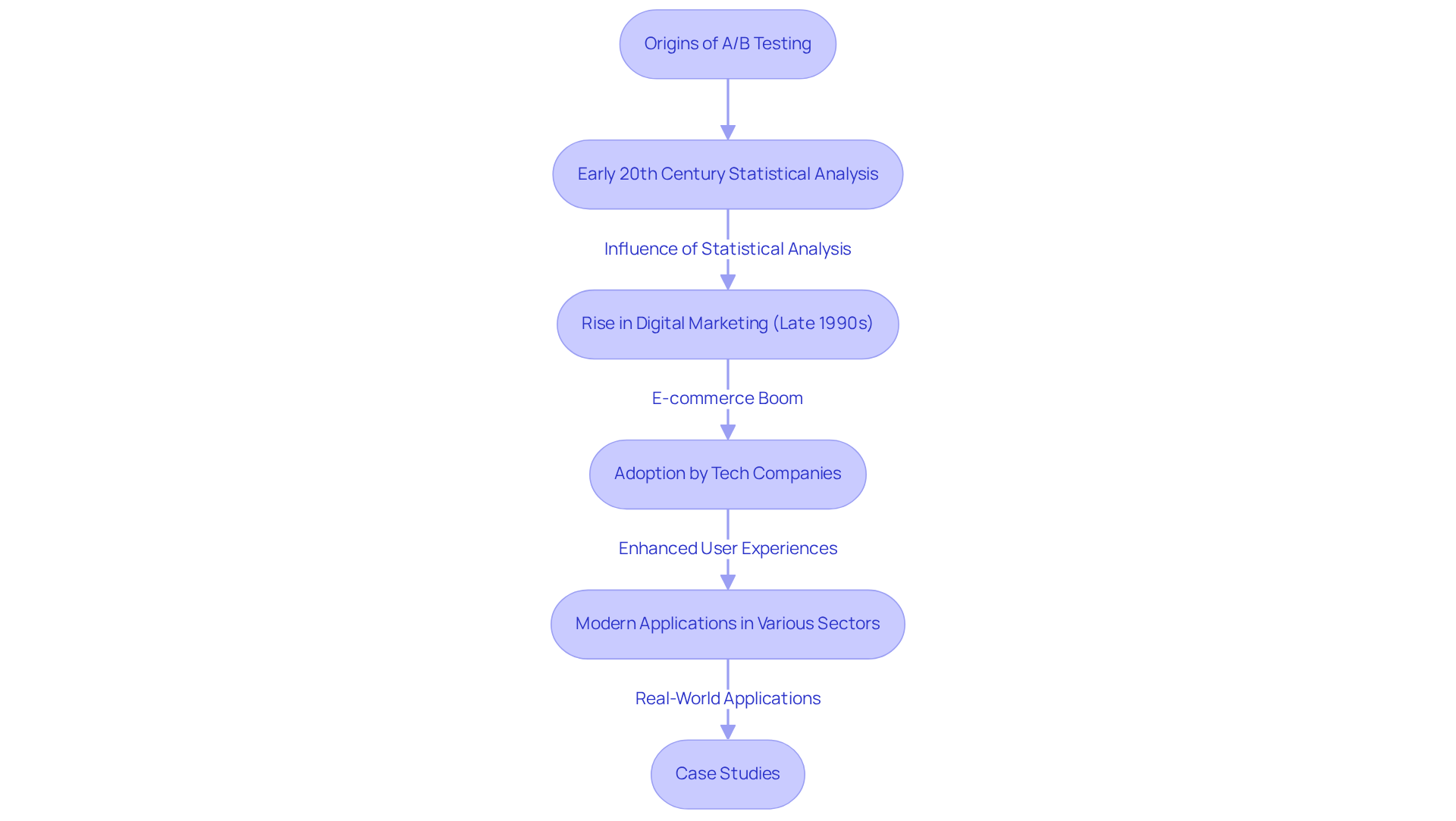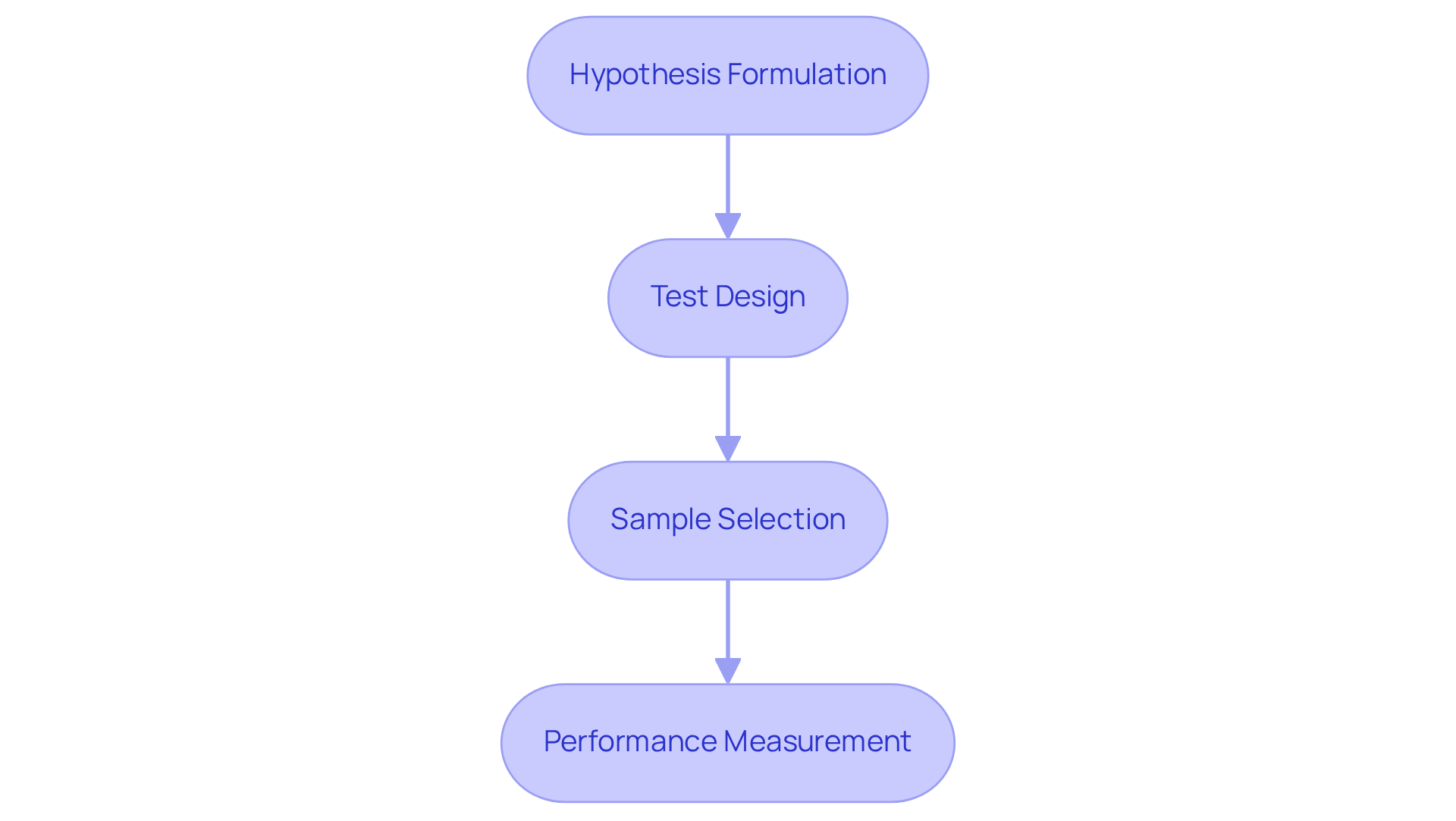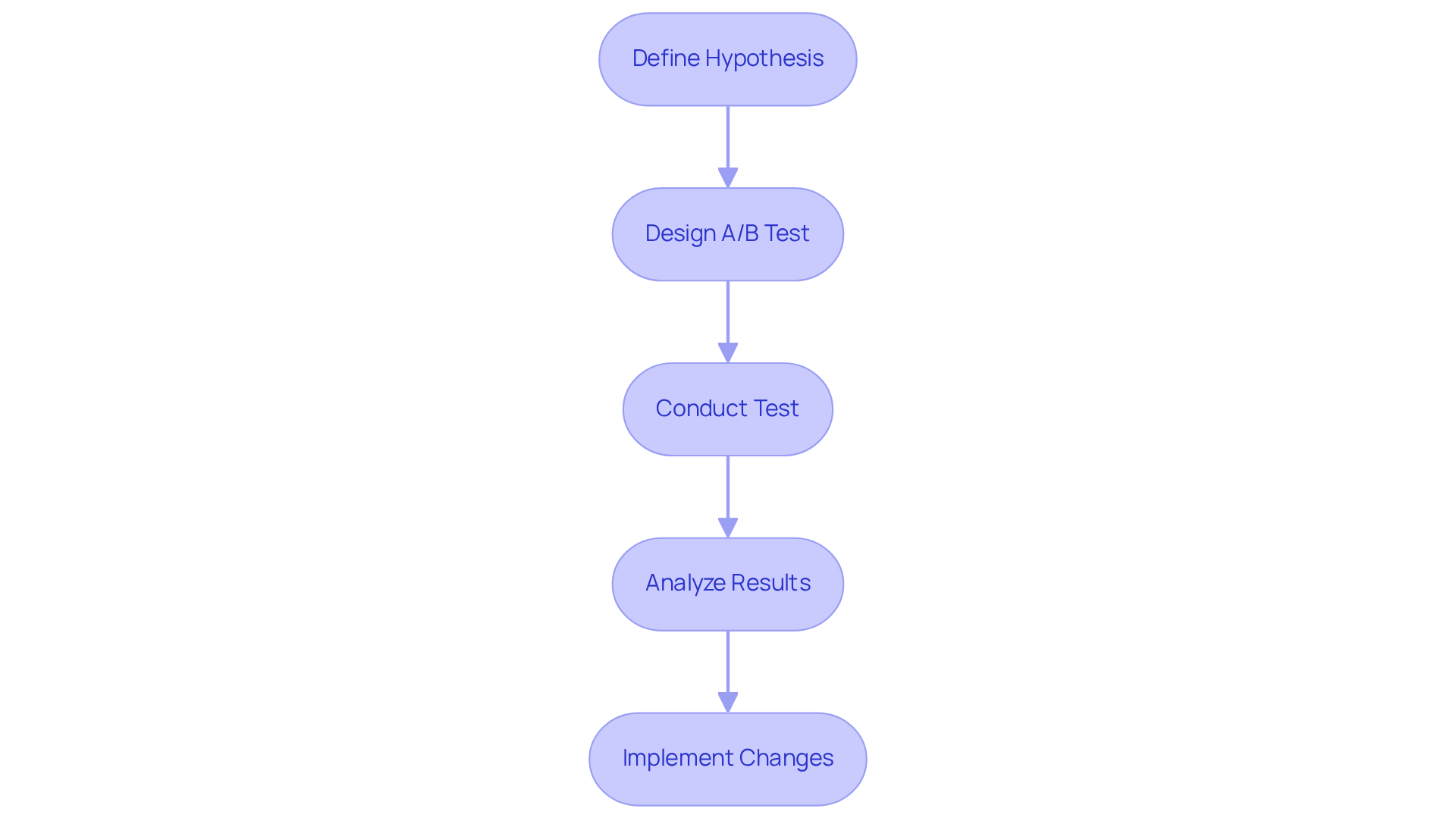
Overview
A/B testing, commonly referred to as split testing, serves as a critical method for comparing two versions of a marketing asset, ultimately determining which one yields superior performance. This approach is indispensable for direct-to-consumer (DTC) brands aiming to refine their strategies.
Through systematic evaluation and data-informed insights, A/B testing can drive substantial enhancements in conversion rates and overall profitability. This assertion is substantiated by successful case studies that illustrate remarkable revenue growth, underscoring the necessity of integrating A/B testing into marketing practices for optimal results.
Introduction
A/B testing has emerged as a cornerstone of effective marketing strategies, particularly for direct-to-consumer brands navigating a competitive digital landscape. This powerful tool enables marketers to compare two versions of a webpage or marketing asset, revealing insights that can drive significant improvements in conversion rates and overall profitability.
However, as brands strive to optimize their approaches, the question arises: how can A/B testing be leveraged not just for incremental gains, but for transformative growth?
Exploring the principles, methodologies, and real-world successes of A/B testing unveils a path for brands to enhance their marketing effectiveness and adapt to ever-evolving consumer preferences.
Define A/B Testing: A Fundamental Marketing Tool
A/B testing, often known as split testing, represents a strategic approach utilized to compare two versions of a webpage, email, or other marketing assets, ultimately determining which performs more effectively. In this methodology, one version (A) serves as the control, while the other (B) functions as the variant. By randomly directing traffic to both versions and measuring their performance against key metrics—such as conversion figures, click-through statistics, and average order values—marketers can extract actionable insights to refine their strategies. This method is particularly vital for direct-to-consumer (DTC) companies aiming to enhance profitability while avoiding additional advertising costs.
The impact of A/B trials on conversion figures in e-commerce is significant, with numerous companies reporting improvements ranging from 15% to 30% after conducting targeted assessments. For instance, a $30 million apparel line achieved an impressive 35% increase in conversion rates by optimizing its homepage based on A/B analysis results. Similarly, a $15 million cleaning product label experienced an 80% boost in average order value through strategic evaluation of free shipping limits.
Expert opinions underscore the necessity of A/B evaluation for DTC companies. Marketers assert that a well-defined hypothesis is crucial for effective evaluation, as it clarifies the experiment's objectives and aids in interpreting results. Furthermore, A/B analysis empowers brands to swiftly adapt to changing consumer behaviors, ensuring that marketing strategies remain relevant and effective.
Numerous successful A/B experiments exemplify the potential within the e-commerce sector. For example, Techinsurance.com observed a remarkable 73% increase in conversions after creating a dedicated landing page focused on targeted messaging. Additionally, a cannabis firm reported a 55% rise in conversion rates through the application of Bayesian methods, showcasing the power of sophisticated evaluation techniques.
In conclusion, A/B experimentation is an essential component of a comprehensive marketing strategy for DTC companies. By leveraging data-informed insights, companies can optimize their marketing efforts, enhance user engagement, and ultimately drive growth.

Trace the Origins and Evolution of A/B Testing
A/B experimentation, often referred to when discussing what is an A/B test, is a practice rooted in the statistical analysis of the early 20th century that gained significant traction in the digital marketing landscape during the late 1990s, coinciding with the e-commerce boom.
Initially embraced by tech companies to enhance user experiences, what is an A/B test has since evolved into a fundamental practice across diverse sectors. The advent of advanced analytics tools has dramatically accelerated its implementation, empowering marketers to conduct large-scale tests and derive valuable insights.
Today, what is an A/B test stands as an essential strategy for DTC brands, enabling them to optimize their marketing approaches based on real-time data. For instance, e-commerce platforms frequently employ A/B trials to refine their purchase funnels, effectively illustrating what is an A/B test by reducing drop-off rates and boosting sales.
Noteworthy examples include:
- Barack Obama's 2007 presidential campaign, which leveraged A/B trials to enhance online engagement by experimenting with various website elements.
- Google's assessment of hyperlink colors to maximize click-through rates.
These case studies illustrate what is an A/B test and how A/B evaluations inform design choices, driving substantial improvements in revenue and user satisfaction, which underscores its critical role as a tool for growth in the digital marketplace.
Furthermore, understanding what is an A/B test assists in determining optimal pricing for new products, addressing a significant challenge in product launches, and is grounded in the statistical principles championed by advertising pioneer Claude Hopkins, which emphasize the importance of statistical significance in evaluation methodologies.

Outline Key Components and Methodologies of A/B Testing
Key elements of what is an A/B test include:
- Hypothesis formulation
- Test design
- Sample selection
- Performance measurement
Each is crucial for maximizing profitability through comprehensive Conversion Rate Optimization strategies. The process initiates with the identification of a specific goal, such as increasing conversion rates, aligning seamlessly with Parah Group's commitment to sustainable growth. Marketers then develop two versions of the asset for testing, which helps illustrate what is an A/B test, ensuring that only one variable is altered to isolate its impact. This method not only leverages consumer psychology but also facilitates a thorough evaluation that propels significant growth.
Sample selection requires directing a statistically significant number of users to each version, thereby ensuring reliable results. Ultimately, performance is measured using metrics pertinent to the goal, allowing marketers to understand what is an A/B test in order to discern which version proves more effective. Continuous iteration based on these insights is paramount for ongoing optimization, reflecting Parah Group's dedication to data-driven decisions that enhance profitability.

Highlight the Importance of A/B Testing in Marketing Strategies
For DTC companies, knowing what is an A/B test is indispensable, as it empowers them to make data-informed decisions that significantly influence their profitability. By systematically evaluating various elements of their marketing strategies, these companies can pinpoint what resonates with their audience, resulting in improved conversion rates and heightened average order values.
For instance, a DTC company that tested two distinct product page layouts found that the version with enhanced visuals yielded a remarkable 25% increase in conversions. Such insights not only bolster marketing efforts but also diminish dependence on expensive advertising campaigns, positioning A/B evaluations as a vital tool for fostering sustainable growth.
Furthermore, case studies reveal that companies employing A/B experiments have achieved substantial revenue growth, with some reporting up to a 36% rise in ROI on advertisements. This underscores the transformative potential of A/B experimentation in enhancing customer interactions and cultivating long-term success.
Additionally, effective setup and thorough post-test analysis are critical for impactful outcomes in A/B testing, which helps brands understand what is an A/B test, accurately evaluate results, and make informed adjustments to their strategies.

Conclusion
A/B testing is a cornerstone of effective marketing strategies, particularly for direct-to-consumer brands. This method not only enables companies to compare different versions of their marketing assets but also empowers them to make informed decisions based on real data. By systematically analyzing performance metrics, brands can identify what resonates with their audience, ultimately leading to improved conversion rates and enhanced profitability.
The article highlights the transformative power of A/B testing in the e-commerce landscape. From its historical evolution to critical components and successful case studies, the evidence underscores the necessity for DTC brands to embrace data-driven strategies. The ability to formulate hypotheses, design tests, and measure outcomes is essential for optimizing marketing efforts and fostering sustainable growth.
In a world where consumer preferences constantly evolve, leveraging A/B testing is not just beneficial; it is imperative. Brands must integrate this practice into their marketing strategies to stay competitive and enhance customer engagement. By committing to continuous testing and optimization, companies can unlock significant growth potential, reduce advertising costs, and ultimately secure their place in the market.
Frequently Asked Questions
What is A/B testing?
A/B testing, also known as split testing, is a marketing strategy used to compare two versions of a webpage, email, or other marketing assets to determine which performs better.
How does A/B testing work?
In A/B testing, one version (A) acts as the control, while the other version (B) is the variant. Traffic is randomly directed to both versions, and their performance is measured against key metrics such as conversion rates and click-through statistics.
Why is A/B testing important for direct-to-consumer (DTC) companies?
A/B testing is vital for DTC companies as it helps enhance profitability without incurring additional advertising costs by providing actionable insights to refine marketing strategies.
What improvements have companies seen from A/B testing?
Companies have reported significant improvements in conversion rates from A/B testing, with increases ranging from 15% to 30%. For instance, one apparel line saw a 35% increase in conversion rates after optimizing its homepage.
What role does a well-defined hypothesis play in A/B testing?
A well-defined hypothesis is crucial for effective A/B testing as it clarifies the experiment's objectives and aids in interpreting the results.
How can A/B testing help brands adapt to consumer behavior?
A/B testing allows brands to quickly adjust their marketing strategies in response to changing consumer behaviors, ensuring their approaches remain relevant and effective.
Can you provide examples of successful A/B tests in e-commerce?
Yes, for example, Techinsurance.com experienced a 73% increase in conversions after creating a dedicated landing page with targeted messaging. Additionally, a cannabis firm achieved a 55% rise in conversion rates using Bayesian methods.
What is the overall significance of A/B testing in marketing?
A/B testing is an essential component of a comprehensive marketing strategy for DTC companies, as it enables them to leverage data-informed insights to optimize marketing efforts, enhance user engagement, and drive growth.
FAQs











